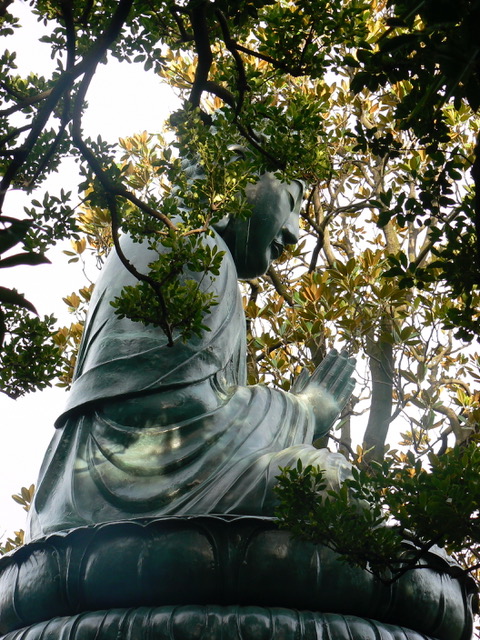Today, nobody questions the historicity of Siddhârta Gautama whose existence was proved at the end of the nineteenth century when a funeral urn containing his bones was discovered in India. This man of exception chose to renounce the pomp of his princely life to devote himself to the happiness of mankind and to the search of the true meaning of reality.
However, the story of Buddha’s life, extracted from numerous biographical elements of Buddhist literature was embellished with many a legendary element. Considering how long ago the texts were written and the scarcity of archaeological relics, one can easily understand the difficulty for scientists to establish a proper biography of Shakyamuni Buddha.
A royal birth
Prince Siddhartha Gautama was born in the 6th century BC (between – 560 and – 480) into the Shakya Clan, in the city of Kapilavatsu in the far reaches of the Himalayas, somewhere between what is known today as India and Nepal. Right after his birth, the son of Shuddhodana, the local king, was introduced to some soothsayers and sages who noticed on his body the presence of the thirty-two obvious signs of a great man. According to the Indian tradition, the child who shows these marks is either bound to become a great monarch whose power will spread over the earth or a Buddha, an Enlightened person. The legend holds that before his conception, Queen Maya had had an astonishing dream: she had seen a six-tusked white elephant, omen of an exceptional birth. The queen gave birth to her son while she was about to pick a flowery branch in a park. The tradition purports the child was born miraculously from her right side, that he immediately started to walk, lotus flowers springing under his feet at every step. He stated his destiny was to reach Enlightenment.

Auspicious signs
One of the sages, who recognized the auspicious signs on the child’s body, told the king that his son would choose the way which leads to spiritual awakening rather than to political power. Hoping to see his son succeed him on the throne, Shuddhodana decided to keep the prince away from all kinds of trouble which might awaken any call for spiritual quest. Shiddarta’s mother died one week after he was born. He was brought up by Prajapati, his maternal aunt who was the king’s second wife. For thirty years he led an idle life protected from the outside by the walls of his palace. He married Yashodara and had a son called Rahula.

The discovery of suffering, starting point of his search
Such a life could have continued in the same way if one day Shiddartata hadn’t felt like exploring his city. He ran into four people who successively confronted him with everything he had so well been protected from for years. First he met an old man, then a sick one thrown into the street by his own family, saw a body carried away to be cremated and finally encountered a wandering monk whose serenity-stamped face seemed to show him the way! Then he came to realize how artificial his own happiness was. He began to devote himself exclusively to the spiritual quest in order to discover the Truth, the causes of human suffering and the keys to solve it.
His spiritual quest
The next six years, he led a wandering life, full of austerity. For two years he became the disciple of two masters. Thanks to them he managed to master perfect control of meditation and mental state. Yet, he turned away from them, unsatisfied, as he could not find what he was looking for, the final and total liberation from the birth and death cycle. Along with his companions he then subjected his body to the utmost privation, assuming that the body and its pleasures were the main obstacles to spiritual realization. About to die, still without an answer, he came to realize that excessive asceticism was just another form of the ego. He abandoned that kind of practice, decided to explore a middle course, far from the extreme ways and became a monk beggar. His companions abandoned him disappointed as they were by this change of practice they mistook for inconsistency.
Perfect and supreme Enlightenment
Having regained his strength, he carried on with his quest. One day, not far from the city of Bodhagaya, he sat down in contemplation under a tree. While focusing on his goal and the idea that life was nothing but a prison, he was suddenly subjected to the assaults of Mara, the God of Hell and illusions who makes sure nobody ever escapes Samsara and attempts to prevent their enlightenment. Mara first launched his army to frighten him then sent attractive women to arouse his desire. Having won the fight, he went through the successive stages of meditation. All his former experiences and thoughts came to make sense. He was able to remember all his past lives as well as those of all human beings’, which enabled him to understand the law governing all existence as well as the mechanism of rebirths: the law of the cause and effect of actions. Prince Siddhârta, Shakyamuni, sage of the Shakya clan, had reached perfect and supreme Enlightenment.
Choosing the offering
After such an event, he stayed for a few weeks on the very spot of his enlightenment. Indeed, it took him a long time to reach the decision to share his experience with other human beings and to show them the way that leads to liberation. He knew that men, blinded by their ignorance and attachments would never understand the Dharma- the truth he had discovered. People say that Great Brahma implored the Buddha not to keep what he had discovered to himself. As a consequence, the latter chose to devote his life to preaching, which he did for 45 years?
Spreading his teaching
He first went to the Deer Park, near Benares, where he met his former companions. He delivered his first teaching on the Four Noble Truths: the truth of suffering, the truth of the causes of suffering, the truth of the possibility of the cessation of suffering, and the truth of the path that leads to its cessation. His companions became his disciples, soon joined by others: it was the beginning of the Sangha, the Buddhist community which kept on increasing. Many members of his clan, including his cousin Ananda who became the main guardian of his teachings, decided to follow him in his trips, on the roads of the Ganges valleys in particular. This life entirely devoted to the transmission of the truth was nevertheless darkened in the last years by barren conflicts in the community and by the treason of Buddha’s cousin Devadatta, who tried to kill him and split up the Sangha.
Buddha died aged eighty. People say, that knowing his time had come, he lay down under a tree and said to his disciples gathered around him : “May the Dharma and the discipline I have passed on to you be your master from now on. All the elements of one’s personality are bound to decline! Try hard, try relentlessly!”
Buddha was not the only aristocrat of his times who left everything behind to dedicate his life to spiritual quest. Nor was he the only one who gathered disciples around him, but the story of his life and teachings – even today – keep on feeding the spiritual life of men and women committed to following the way leading to Enlightenment he had opened up. How marvellous the immeasurable power and magnificence of this teaching!
Photographie : Jean-Benoît Dupont (haut) Kazuend (millieu)
